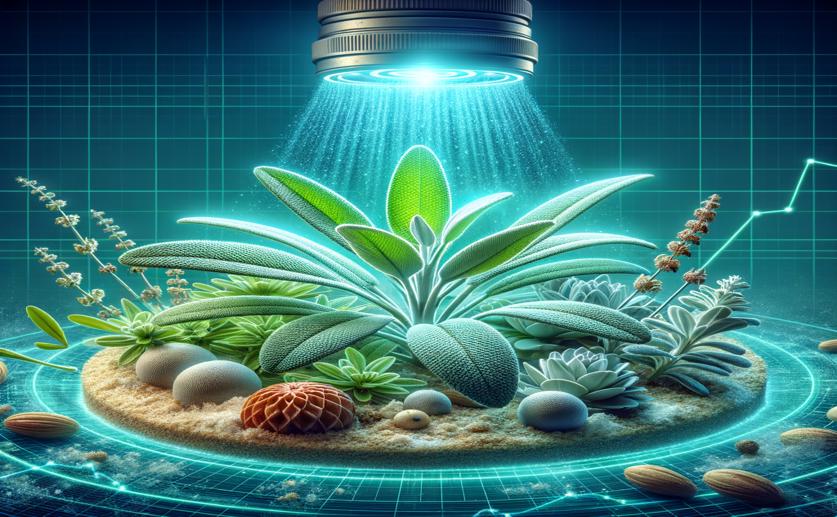Laser Light Boosts Salt Tolerance and Health Benefits in Sage Plants

Image Source: Natural Science News, 2024
Key Findings
- The study by Shahrekord University, Iran, investigated how He-Ne laser priming of Salvia officinalis seeds can help plants resist salt stress
- Salt stress reduced plant growth, chlorophyll content, and water content, while increasing harmful substances like MDA and H2O2
- He-Ne laser and H2O2 priming increased beneficial compounds and antioxidant capacity, reducing oxidative stress and improving plant health under salt stress
In recent years, researchers have been investigating how Helium-Neon (He-Ne) lasers can help plants resist stress and enhance secondary metabolism. However, the exact signaling pathways involved in these processes have remained unclear. A new study by Shahrekord University, Iran, aimed to uncover the role of RBOH-dependent signaling in He-Ne laser-induced salt tolerance and secondary metabolism in Salvia officinalis[1].
Salt stress is known to hinder plant growth, reduce chlorophyll content, and increase harmful substances like malondialdehyde (MDA) and hydrogen peroxide (H2O2) in plant leaves. This study focused on how He-Ne laser priming of seeds could mitigate these negative effects. Researchers primed Salvia officinalis seeds with He-Ne laser (6 J cm-2) and hydrogen peroxide (H2O2, 5 mM) and then exposed 15-day-old plants to two salinity levels (0 and 75 mM NaCl).
The findings revealed that salt stress reduced growth parameters, chlorophyll content, and relative water content (RWC) in the plants. It also increased MDA and H2O2 contents in the leaves of 45-day-old plants. However, when seeds were primed with He-Ne laser and/or H2O2, the plants showed higher transcription levels of RBOH (encoding NADPH oxidase), PAL (phenylalanine ammonia-lyase), and RAS (rosmarinic acid synthase) genes after 48 hours of salt exposure. This upregulation was associated with lower H2O2 and MDA contents after 30 days, indicating reduced oxidative stress.
The study also found that seed pretreatment with He-Ne laser and/or H2O2 led to increased accumulation of beneficial compounds like anthocyanins, total phenol, carnosol, and rosmarinic acid. These treatments also boosted the plants' total antioxidant capacity, particularly under saline conditions. Improvements in RWC and K+/Na+ ratio, enhanced activities of antioxidant enzymes such as superoxide dismutase and ascorbate peroxidase, and increased proline accumulation were also observed. These changes significantly decreased membrane injury and H2O2 content in the leaves of 45-day-old plants under salt stress.
Interestingly, the beneficial effects of laser priming were reversed when diphenylene iodonium (DPI, an inhibitor of NADPH oxidase) and N, N-dimethyl thiourea (DMTU, a H2O2 scavenger) were applied. This reversal resulted in the loss of laser-induced salt tolerance and secondary metabolism, suggesting that the RBOH-dependent H2O2 burst plays a crucial role in these processes.
These findings align with earlier studies that have explored similar mechanisms in different plant species. For instance, a study on Dracocephalum kotschyi Boiss showed that melatonin and calcium signaling could enhance photosynthesis and salt tolerance by boosting antioxidant enzyme activities[2]. Another study on tall fescue leaves demonstrated that He-Ne laser illumination could alleviate salt stress by increasing intracellular calcium concentration and antioxidant enzyme activities, mediated by nitric oxide signaling[3]. Additionally, research on Arabidopsis thaliana revealed that low-intensity laser radiation could increase the content of antioxidant compounds like anthocyanins, kaempferol, and quercetin, enhancing the plant's overall antioxidant potential[4].
The current study expands on these earlier findings by elucidating the role of RBOH-dependent H2O2 signaling in He-Ne laser-induced stress tolerance and secondary metabolism. By priming seeds with He-Ne laser and/or H2O2, the researchers were able to induce a transient burst of H2O2, which acted as a downstream signal to promote secondary metabolism and alleviate salt stress in Salvia officinalis.
In summary, this study from Shahrekord University provides new insights into the molecular mechanisms by which He-Ne laser priming can enhance plant stress tolerance and secondary metabolism. It highlights the importance of RBOH-dependent H2O2 signaling in these processes, offering a potential strategy for improving plant resilience to environmental stresses.
MedicineBiochemPlant Science
References
Main Study
1) RBOH-dependent signaling is involved in He-Ne laser-induced salt tolerance and production of rosmarinic acid and carnosol in Salvia officinalis.
Published 24th August, 2024
Journal: BMC plant biology
Issue: Vol 24, Issue 1, Aug 2024
Related Studies
4) Involvement of Photoprotective Compounds of a Phenolic Nature in the Response of Arabidopsis Thaliana Leaf Tissues to Low-Intensity Laser Radiation.
https://doi.org/10.1111/php.13289
Related Articles





 9th August, 2024 | Jim Crocker
9th August, 2024 | Jim Crocker